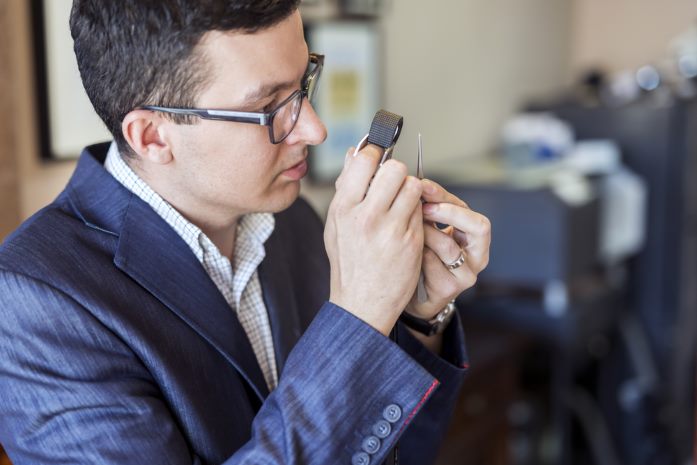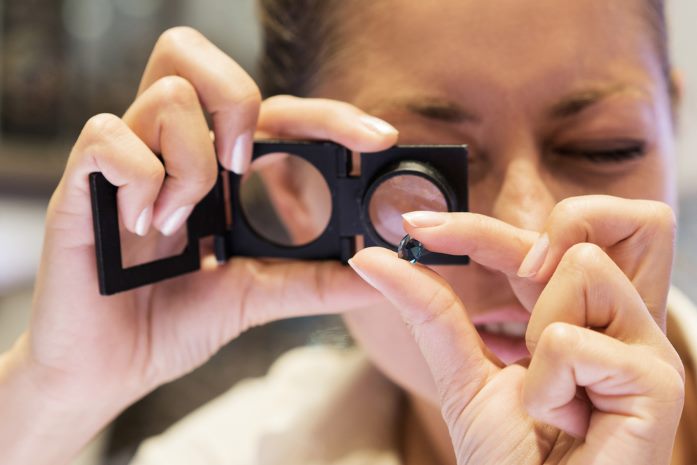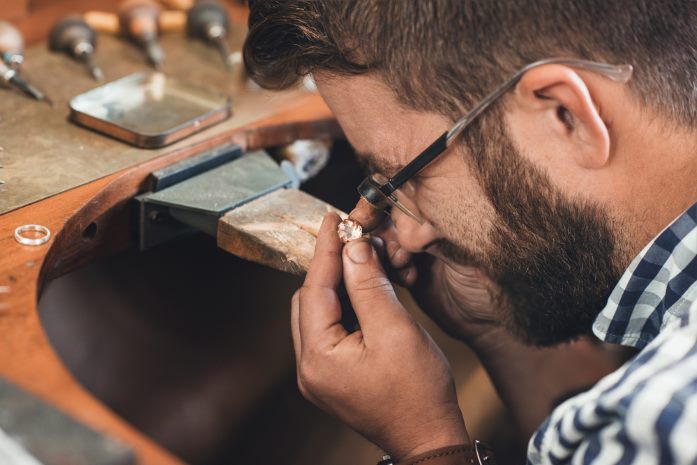
What makes diamonds so mesmerizing to the entire world is their natural beauty and spectacular capability for brilliance.
These natural gemstones have always sparked the imagination and captivated us. So, it goes without saying that generations to come will continue to find these hypnotic gems fascinating until the end of time. That said, diamonds are most always produced with certain characteristic flaws or inclusions—these are so emblematic of their true nature, that we would be suspect if we didn’t see them with these identifying traits. The natural inclusions (or blemishes, or flaws as they may be called) are basically a hindrance to their potential for brilliance that they would otherwise exhibit if they were flawless.
But thanks to the development of advanced technology, now we have a variety of superb diamond clarity treatments that are largely created for the express purpose of improving (or enhancing as it’s called) the clarity of any diamond subjected to that treatment. With that in mind, both laser drilling and internal laser drilling which are two separate techniques are gaining in popularity with diamond manufacturers for delivering remarkable clarity treatments in diamonds.
Explaining the Laser Drilling Process
Laser drilling as it relates to diamonds, is basically a specialized process involving the application of infrared lasers to drill a tiny hole, much thinner than a hair into the diamond crystal, in order to create a way to reach and obliterate any blemishes–from the crystal’s surface right into the inclusion inside the diamond. Once the exact internal location of the blemish to be removed is reached, the newly created hollow channel is used to dissolve or otherwise remove these inclusions by either melting them with highly directed intense heat or by dissolving it completely with a specialized acid. The process makes the inclusion less apparent and for most consumers—and even jewelry tradespeople –it can simply seem to disappear completely. This technique is most often the treatment of choice which is usually adopted to diminish the most unattractive inclusions like dark or even black spots.
Comparing 2 popular clarity enhancement techniques: Laser Drilling vs Special Laser Drilling
Now that you understand this modern technique, you may still be wondering if these delicate microscopic laser drill-holes can be readily seen with the naked eye. The simple answer and good news is they are so minuscule after treatment that locating them will become a definite challenge, even with a careful examination. Isn’t that good news? After all, most consumers would be happy to learn that they can have a luxurious looking diamond—which is bigger and brighter than they ever thought possible—and buy it at a much more attractive price than they ever dreamt. This becomes possible because laser drilled diamonds are offered for sale at much more affordable pricing than their un-treated counterpart. And the best part? No one knows that the dazzling large sized diamonds were laser treated except the savvy owner who did his or her homework in searching out these spectacular diamond products.

Moreover, the laser techniques applied to natural diamonds in no way affect the brilliance of the diamond that was treated. Under a microscope viewed by a knowledgeable jeweler or gemologist, these sparkling beauties can be easily detected if they know what to look for. In some instances, the drilled hole has later been filled with strategically implanted substances that mirror the optical performance of diamonds—and that filler further diminishes any remaining visibility of that hole for the most part.
It’s important to understand that the laser-drilling procedure will be permanent in that crystal. Once any diamond has been laser drilled—its clarity is immensely improved and warrants a new completely new clarity grade which remains in effect forever.
Let’s Talk Internal Laser Drilling and the KM Treatment
If you read enough about the high-tech processes applied to diamonds to improve their appearance you will eventually come across laser treatments explained and even something called KM treatment. By learning a bit more about these processes, you’ll have an understanding of what they are, and the benefit to the diamond that they provide. The KM treatment is basically just another variation of the more well-known laser drilling technique. And these have been used in the industry for some time now. The letters KM are an abbreviation of the Hebrew words “kiduah meyuhad”. Th rough interpretation of these words imply “a special drill”. In this particular method, a very hot laser is focused directly at an internal inclusion. In turn, it causes the targeted inclusion to enlarge. It could also result in additional internal fractures (inclusions). The purpose of this is to allow for the development of a series of fractures that extend from the inclusion (inside the crystal) out to the surface of the crystal, in order for the acid to reach inside the crystal so it can lighten or clean out the dark looking inclusions and produce a sparkling clean looking crystal. The KM laser drill-holes may produce a number of different appearances. Some of these drill holes may appear like an irregularly shaped worm hole. Others may produce some irregular boundaries while others will display interesting disc-like features. Any of these various irregularly shaped or worm-like tunnels can be regarded as being naturally occurring flaws. Because as we know, with few exceptions, all diamonds are brought from the earth with abundant natural inclusions (blemishes or flaws). The delicate resulting feather created as a bi product of this laser drilling technique is quite difficult to discriminate with the unaided eye. As we’ve said, however, it can be easily identified by an expert jeweler or gemologist under a microscope using different lighting techniques.

Advantages of Treatments like Laser Drilling or Internal Laser Drilling
To be clear, any of the laser treatments applied to diamonds are always done to eradicate their naturally occurring flaws, and to make each diamond more visually appealing– and in turn to make them more salable. That’s the whole point for both the merchant—who wants a beautiful product that appeals to the client—and the shopper who is eager to buy a spectacular diamond with the budget that is manageable. Any of the modern processes including laser drilling and the special KM process achieved these goals. Any type of lasering can essentially eliminate the most easily detectable flaws and transform that lasered diamond into an eye-cleaned crystal. Eye clean diamonds actually exist in real life without treatment. But they are rare occurrences and as such, their prices are often as much as ten times more than the lasered diamond which after its treatment appears like it’s almost flawless.
Another big advantage besides their much-improved appearance to the laser drilled diamonds is of course that after the treatment they are available at very affordable prices. For instance, a diamond that underwent any laser drilling treatment for clarity improvement may now cost approximately 20to 30 percent less than an untreated stone of similar quality and categorized as having (now) the same clarity grade. These interesting tech-modified diamonds become an ideal option for shoppers with budget limitations; but for those who understand the 4Cs and the quality components that make for a beautiful diamond. At the same time, these consumers know that they have their eye on purchasing the largest sized diamond they can afford.
Are there Downsides to Owning a Laser Drilled Diamond?
Massive clarity improvements in a diamond crystal also means that innumerable drill holes may have been applied to the stone. The greater number of holes drilled in a stone, the weaker may be the structure of that particular diamond. So, the prominent enhanced diamond manufacturers today solve that potential downfall by sourcing good quality diamonds to begin with. The other parts of the 4Cs—which are cut, clarity, carat weight, color—are fine traits. The only area it falls short is the clarity aspect. This helps maintain the end result of a good diamond with improved clarity.
In the case of lasered diamonds that had too many tunnels drilled in them—we know it can impact the durability of that particular stone. This however is not a consideration, when as mentioned the quality of the treated diamonds have a few inclusions treated. But as always, it’s good to know the whole story and also to have confidence in your diamond merchant—who will convey confidence to you in their products. As a consumer, one needs to be aware of this possibility. Responsible diamond merchants will always disclose their products to the public. They want them to be aware of what they are buying. Ask your diamond vendor if he or she places an identifying inscription on the girdle of the diamond. Many reputable dealers do that today. Another appropriate way to determine if a diamond has undergone a laser drilling procedure is to ask for and inspect the diamond’s certificate. A diamond grading report issued by GIA (Gemological Institute of America) or any other of the several independent laboratories will provide you those details.
KM Diamond Lasering -v-Traditional Laser Drilling
During these past decades, laser technology has grown ever more sophisticated. Israeli diamond producers have developed newer methods of drilling, or Kiduah Meyuhad, a Hebrew phrase for special drilling. Instead of the more conventional laser drill-hole—which appears like a miniscule tunnel, the KM produces a wider—almost ‘sheet-like’ delicate feather edging up to the stone’s surface. This kind of lasering procedure is visible when viewed under loupe (10X) power magnification or seen through the microscope. This special technique produces a laser result which can look very natural if the procedure has been done successfully. Its goal of course is to eradicate the darker natural blemishes, as it bleaches out those blackish inclusion. Because of that, it is often difficult to separate KM treated inclusions from those that are naturally occurring.
Not that long ago, EGL or European Gemological Labs, found evidence of a newer generation of these kinds of treatments — specifically referred to as Micro KM. At 10-X magnification up to even 100-X enlargement, this new kind of laser drilling appeared to be confined in a way within the diamond crystal, so it actually appeared as if it had not been subjected to any sort of treatment. The only way possible to be actually able see and identify this new treatment would be to place it under high powered magnification is under 200–X and even closer to1,000-X magnification.

To demonstrate just how miniscule this newer treatment really is, scientific research noted that the break to the crystal surface affected by Micro KM would only be about five microns in total. By comparison, imagine that the width of a human hair is only about 80 microns. This treatment is 16 times smaller than a human hair, if you can picture it. In other words, this advanced treatment makes the resulting drill-hole essentially an invisible treatment.
While it’s an extraordinary breakthrough, and one that positively impacts the outcome of treated diamonds overall, there are some other considerations to discuss. Professionals debate that this new treatment –because of its nearly invisible results, will also raise a grave issue, even though it is only available for application to crystals designated SI grades or even lower on the grading scale.
After considerable deliberation, the Federal Trade Commission (or FTC) ruled some years back that disclosure of laser drilling is always warranted on these products prior to them being offered for sale. This helpful law adds another layer of protection for the consumer. And reputable dealers are certainly onboard with such a mandate. They want their consumer to understand what they are buying and have confidence in them as a good provider of products that are also a good value. But unless the stone is certified ahead of time—or at the point when the manufacturer offers it for sale to designers, retailers or online vendors, how could any professional disclose that fact to their consumer since the resulting treatment can’t even be observed under a 100-X jewelers loupe? And of course, the question remains that even if they did disclose the treatment to the consumer, does knowledge of such a miniscule dot assist the consumer in any practical way when making a purchase?
On the whole, laser drilling has been a specialized technique in place within the diamond trade beginning in the mid-60s to improve a diamond’s clarity and salability by eliminating un attractive crystals or other visible blemishes like iron oxide inclusions.
In traditional laser drilling that was developed over a half century ago, a slim infrared laser consisting of a wavelength of approximately 1060-nanometers will drill minute holes (often called tunnels) of less than 0.2mm in diameter in width. These drill holes allow access to the inclusion that is to be removed. Once the desired inclusion has been removed by laser, the diamond is then immersed in sulfuric acid which serves to take away any residual dissolved crystal inclusions or other chemical stains.
Laser drilling of various kinds can be employed on numerous natural inclusions in the same diamond crystal. And all of that effort leaves apparent signs (if one knows what to look for) that are readily visible viewed under a microscope. For example, the drill holes themselves have a whitish, or even wrinkled appearance. And in reflected light, those drill holes that reach the stones’ surface can be observed as being darkish circular shapes.
A couple decades back, the KM short for Kiduah Meyuhad in Hebrew created a new era in laser technology, hence its Hebrew name of special drilling. Th technique developed.as KM laser drilling is said to be ideally suited to treat lower quality diamonds with inclusions that lie near to the crystal surface. That is because the KM procedure specifically leaves no tell-tale drill holes, and furthermore, it is therefore a greater challenge to actually identify these treatments than is possible with standard laser drilling. However, upon closer inspection, these KM-treated diamonds actually reveal some internal traces of their laser drilling; evidence such as wormhole effects found near the site of the former inclusion that was removed.
Like all diamond treatments available in the gem trade now, any type of laser drilling—no matter what type it is, must be disclosed whenever that diamond is being submitted to an independent gemological laboratory for its grading process.
The landscape of professional laser drilling has undergone a radical change in the last decade or two. The newer and some said unexpected technique showed up inside the gem trade—the one that was eventually labelled the KM treatment — or short for kiduah meyuhad, meaning special drill in Hebrew. The Gemological Institute of America (GIA), the preeminent independent diamond and gemstone institute, reported on this newer method, not long after it was first introduced, in the Summer 2000 edition of their trade publication called Gems & Gemology. At the time of its initial development, the process was basically characterized by an unusual presence of damage that was left behind by the laser work itself. This damage, it was noted, was always restricted to surface-reaching feather-like structures which scientists say resembled irregular tunnels or as they put it, “wormholes.”
Once these identifying characteristics of the treatment were identified, it called for the next stage of evolution of this highly technical treatment. With further technology, the general appearance of the laser impairment began to modify for the better. The technology evolved to such an extent that it almost became invisible. This is because the treaters were now attempting to make the indication of its lasering more and more problematic to distinguish. Over the past decade or more, GIA has inspected numerous variations of this specialized laser procedure.
Major Changes in Appearance of Laser Treated Diamonds
One of the first and most prominent changes to the look of laser treated diamonds handled with the KM variation was a more localized manifestation of these laser-induced tunnels. So, rather than observing the traditional elongated, curvy attributes previously seen in early 2000s, they were certainly becoming increasingly thinner, with more compact clusters of lines in an almost circular conformation. It was almost as if someone had been doodling on a sheet of paper, some people pointed out.
These compact groupings of natural blemishes—or inclusions, were usually black in tone, most often dark at least—which obscures the light performance desired inside a diamond crystal. Sometimes, however these inclusions would appear to have a frosted look and some were even a white tint. It just depended on the nature of the inclusion. As time went by and more of these methods were applied to diamond parcels, it could be seen that the lines within these clusters had overlapped to such an extent with one another that they really bore the impression of being a single, disk-like area having an overall sugary texture to the space. In these cases, it was noted that the once Individual lines could no longer be differentiated using standard microscopic examination of either a 10-X jewelers loupe or a microscope.

This transformation was key to the clear identification of these treated diamond products. It was an important enough issue to cause GIA to publish an up-to-date review in their special laboratory news section called Lab Notes in the Summer 2002 edition of their coveted trade journal, Gems & Gemology. It’s important to point out however, that these newly created discs were still limited to the plane of the feather-like structures created by the procedure itself. And through careful observation at a higher magnification level the laser treatment could be identified. With the aid of a specialized fiber-optic light sources, these identifying feather-lines could often be detected appearing within the disks going in several different directions on the same stone. This would not happen in nature, so it is a decisive tell-tale sign of man-made intervention via the use of laser treatment.
Later occurrences of this unique process became the subject of laboratory notations especially in the case where laser damage took the form of unnaturally occurring dot-like shapes clustered together. Some examples for instance, involved the appearance of a string of various of these dots. And in other cases, there was just one or two dots observed in their magnification. Understandably, the latter events were most often extremely problematic to actually locate and identify. In addition to that challenge, there have appeared myriad of instances of tiny, straighter lines seen within these feather-like structures. While it’s not prevalent, it must be noted that in Isolated cases were also times when it was detected that the KM method was used effectively to bridge one completely internal natural blemish with a second such inclusion that completely reached to the crystal surface, thereby allowing both of them to be effectively bleached out in one treatment procedure.
Moving Ahead
Today that the specialized almost invisible treatment is evolving on an ongoing basis. That’s because both vendor and consumer want the best possible diamond at the most attractive price. The KM process delivers an almost flawless looking diamond, vibrant and light reflective, just the way that everyone wants the stone to look. Since it is a lab process that delivers this extraordinary product, and it’s clearly identified through laser inscription on the stone and via the grading report—it is a much more affordable diamond to purchase. Who doesn’t want that win-win situation? This is why the laser diamond niche is finding a greater customer base each year as more and more of these products enter the marketplace and people who knew little about the differences in diamonds begin to discover them.
These techniques are continuously being modified every day in an effort to camouflage the presence of treatment and to produce an ever-clearer diamond. What is most notable about the whole diamond treating sector of course, is that ability to acclimate and importantly regulate these delicate lasers to reach the point where these incredibly minute, delicate operations can be achieved; especially when these treatments are becoming more and more problematic to distinguish.
Here’s where the topic takes another turn and becomes even more interesting to the diamond professional and the jewelry collector too. In addition to work involved in the latest KM treatment, GIA has also been witnessing something called laser damage in diamonds that has become most difficult to explain. It seems the technology evolves so quickly that even the largest laboratories who must keep up with the latest procedures—can find themselves a few steps behind. It means they need to keep ever vigilant in observing and responding the latest treatments entering the marketplace now.
Of course, since this technology has its tell-tale signs, we know there is no doubt that these specific sings are the result of treatment via a laser procedure. But because this is a newer technology within the scope of laser enhancement, its purpose often remains quite unclear. Some examples to be aware of include are those expected laser drill holes—the ones that do not lead to an inclusion. Laser induced damage similar to that which is the direct cause of the specific KM treatment not related to a feather-like object or even a crystal that may not reach the surface, plus those small feather-like objects producing dark lines down the center extending inward from the girdle area of the stone– but do not lead directly to any internal blemish. Frequent examples of the latter evidence have been observed over time. GIA, (Gemological Institute of America) figures that this sort of laser harm may really be an unintended by-product of the application of delicate lasers utilized in the sawing and reshaping process of rough crystal. The exact cause, however, needs further research with verifiable samples of diamonds showing those indications. So up until now, until further data comes in, the cause still remains an uncertainty.
One detail that remains certain however, is that modern laser technology is expected to continue with vast improvements in the future. Gemologists, diamantaires, manufacturers, and retail jewelers all must keep up to date with these extraordinary developments including the effects –both intentional and unintended that they will bear on the future of advanced diamond treatment methods. *
The overall expression referred to as diamond enhancements are specific diamond treatments, performed only on natural diamonds (in large part those that have already been cut and polished into gemstones. These processes are dedicated to improving the visual appeal, salability, beauty, and the optical characteristics of the diamond so that it handles light in the most optimum way possible. Excellent top quality natural diamonds, meaning those which have not undergone any sort of treatment whatsoever are extremely costly and out of the range for most individuals wanting to buy a diamond. These specifics include but are not limited to, clarity enhancements such as laser-drilling that serves to remove black-like carbon blemishes deep within the stone, fracture-filling that makes minor internal flaws less obvious. It also covers the area of color irradiation and similar diamond annealing treatments; changing yellow and brownish stones into attractive vibrant fancy colors such as vivid yellows like the natural canary diamond, and blue tones like turquoise and teal, or even the much-coveted hues of various pinks.
International governing bodies like CIBJO and other governmental agencies more familiar to many of us such as the United States Federal Trade Commission, or USFTC, expressly mandates the disclosure of any and all diamond procedures done to the stone at the time of sale. Some treatments, chiefly those that relates to the diamond’s clarity, remain highly debated within the jewelry industry. These ongoing disputes arise from the traditional view that diamonds as a sentimental object hold a unique or “sacred” place above all gemstones. As such they should not be treated so drastically. This is especially true in their mindset if for no other reason than it could create a fear of damaging consumer confidence in the diamond sector.
Clarity treated and color enhanced diamonds always sell for lower prices than when one compares them to similar quality fine, untreated diamonds. This is solely due to the fact that enhanced diamonds were originally lower quality to begin with—and purchased at lesser costs than other diamonds before the enhancement procedure was performed. In the end, these treated diamonds have their own pricing grid, and are priced at a substandard level if contrasted to the same quality un-enhanced diamonds. After enhancement however, the diamonds will be visually much more appealing and look as stunning as a high priced natural diamond. In reality one can truthfully say that they are as desirable as their non-enhanced cousins.
What exactly is the clarity that we talk about so much? Do you really understand what it means in a practical sense? Of course, we can distinguish between a gorgeous crystal clear top-quality diamond—and the duller, lower clarity stone. But everything in between can be more of a challenge to distinguish. The diamond’s clarity, or purity, of that diamond refers to the absence or presence internal inclusions (blemishes or flaws) of a diamond. Clarity is also one of the very critical 4-Cs of a diamond grading system, and one that is key to determining a diamonds’ value.
Common inclusions (flaws) that usually appear inside natural diamonds are often black carbon spots, or at least very dark in color, and small cracks, commonly referred to as “feathers” because they have that form of a bird feather with small lines flowing from a central line. Fractures or the feathery whitish flaws have a clear appearance when viewed from above or possibly through the side view of the stone. But because we’re talking about natural earth mined objects, diamonds may also possess other natural occurring inclusions such as clusters of air bubbles and even different mineral deposits like iron stains or garnet crystals. The size, shape, color, and even the position of these included objects are factors that fold into determining the value of a particular diamond; especially when the other gemological traits are of a higher more acceptable standard.
Laser Drilling Treatments Began Mid-20th Century
The ever-expanding development of laser drilling techniques in the modern world have only increased this sector’s ability to selectively target, eradicate and meaningfully lessen the visibility of those difficult unattractive black-like carbon flaws observable through a magnifying device of some kind like a 10-X jewelers loupe or even a microscope. Here is something to consider; diamonds containing hematite (a magnetically charged metallic mineral) inclusions have been laser-drilled for greater salability since the mid twentieth century, specifically the late 60s. In a technique credited to Louis Perlman who conducted successful testing just a year after General Electric Corporation (GE) had made a similar test with a diamond for industrial use in 1962.
Although this is a more scientific discussion, you will want to learn that the laser drilling procedures always includes the use of an infrared laser (surgical grade at a wavelength of around 1064 nm) which are used to bore very minute drill holes (of less than 0.2 mm or 0.005 inches in diameter) into a crystal thereby creating a direct straight route of access right into the diamonds’ dark carbon inclusion. Because the diamond material by nature is actually transparent to the wavelength given off by the laser beam, it is necessary for a coating of amorphous carbon or other similar type of energy-absorbent substance is first applied to the surface of the diamond being treated prior to initiating the laser-drilling process.

At that point, the laser beam then burns a narrow hollow tube or channel to that targeted inclusion. Once the exact locale of included black or dark looking carbon crystal has been accessed by the drill channel, the diamond is then soaked in a sulfuric acid solution to finish the job by dissolving those blackish carbon crystal inclusions. After a long soaking process in the sulfuric acid solution, the unwanted black carbon inclusion will now dissolve and be rendered fully transparent (colorless) and sometimes even turn a slightly whitish opaque tint. Under microscopic examination those fine drill or bore holes are somewhat visible if one knows what they are looking for. But all told, they are still not very distracting so as to hamper their beauty and so they do not affect sparkle or brilliance of the diamond. And that is the desired goal of all this technological effort. While these drilled channels are usually basically straight in direction from the entry point on the stone’s surface, some drilling techniques actually occur from within the stone. But using those naturally occurring fractures inside the diamond to reach that inclusion in a way mimics the organic feather-like occurrences. This specific method is ofttimes referred to as a KM drilling process which means special drilling in the Hebrew language. The channels are microscopic of course, which is all part of the laser process, so that unwanted dirt or other debris will not be able to travel down the channel and clog the interior of the diamond—making it dull and less reflective as a stone. On the other hand, a surface-reaching laser drilled hole can only be seen by means of reflecting light bounced off of the surface of that diamond during a microscopic inspection such as a jeweler’s 10-X magnifying loupe or a microscope. At this point, it’s safe to say that because they are so minuscule, they remain invisible to the un-aided naked eye.
Fracture filling and the Laser Process
When one discusses laser drilling processes, the topic of fracture filling will soon enter the conversation. Once a hole has been made in a diamond crystal, there may be the need for filling the void left by that lasering. So these topics are often discussed hand-in-hand since they may be 2 parts to the same procedure.
While fracture filling as a process used to enhance many different gemstones besides diamonds. But unlike colored gemstones which are composed of several different chemical elements, diamonds are the only precious stone composed of just a single element. That alone makes it a rare natural occurrence. And it is the hardest known substance in the world. Diamonds have been found thousands of years ago. A diamond’s unique refractive index (RI), how it handles light entering the stone, mandated a much more advanced resolution than the simple wax and oil treatments that have been applied to colored gemstones for thousands of years.
This additional and useful technology became available roughly 20 years after the time that the first kind of laser drilling techniques were developed. In plain words, a fracture filling process makes those minute natural fractures deep inside the diamonds less visible to the naked eye or even under a magnification device. Fractures are very common inside diamonds—if one does not see at least minute evidence of natural diamond growth, the diamond would be held to question if it is really a natural diamond indeed. Those ‘flaws’ were created during the diamond’s growth deep inside the earth’s crust, approximately 125 miles below the surface of the earth.
As the diamond crystal travels up through the earth’s crust including via volcanic pipes in the earth, it undergoes extreme stress and pressures all while subjected to extreme heat; this changes the composition of the carbon from a dark-black opaque material into the scintillating brilliant stones that we have grown to admire. During this long and extensive travel, there are tiny fractures forming inside the diamond as it yields to pressure and heat.

If these fractures are abundant, clearly visible to the naked eye and they impact the beauty of the crystal, it will result in a stone with much lower demand and won’t be as salable to jewelers and the general public. This is what makes them good candidates for the fracture filling procedure since the object of the treatment is to visually improve the appearance and raise the clarity grade of the diamond itself. The treated stones will have a lot of consumers willing to select them for their very own. The fracture filling procedure for diamonds is often the very last step in a series of important processes of diamond enhancement right after applying laser drilling procedures and acid-bathing of resulting inclusions. Keep in mind however, if those fractures are actually surface-reaching, no extra drilling may be required; the filling mixture can simply be inserted from the opening at the surface. The filling solution present in these fracture-filled diamonds can often be detected by a knowledgeable gemologist who has training, observable under the microscope.
FAQ’s
Are Laser-Drilled Diamonds a Good Option?
With all the discussion about the various types of laser procedures, it helps to simplify the topic and look at the elements of the process step by step.
What does laser drilling actually mean?
Drilling tiny often microscopic tunnel-like channels into a diamond to raise its clarity.
Why are diamonds treated to laser drilling?
Any of the laser drilling procedures are the best way to improve the clarity of a diamond crystal.
How is it done?
The process involves laser technology to drill minuscule holes that are actually much thinner than a hair into the stone, often from its outside surface to an inner inclusion inside the stone.
What is done to the resulting channel created by the laser?
This channel then becomes the pathway carved out to eliminate the blemish by either dissolving it with intense heat or via the application of an acid solution.
Laser drilling is usually used to remove more obvious inclusions such as black spots.
Can Laser Drilling Greatly Improve Clarity?
Nowadays, in most cases, a clarity improvement can be raised in a laser-drilled diamond of about one full grade up. For instance, if your stone in question has been clarity graded I1, the use of laser drilling can reasonably lessen and even eradicate some of the more troublesome blemishes, bumping that diamond’s clarity grade up into the SI range. Even with a spread, it will turn that stone into bearing a new clarity grade of SI2 or SI1, which is a very attractive clarity grade range.
It would be rare to see a greater improvement in clarity of more than two grades for example. But one full grade is a marked improvement and makes the stone more salable and attractive. It is completely impossible of course to see such a vast jump up in the clarity grade. But it all comes down to accepting a trade-off between the looks of the treated diamond and its newfound sturdiness as a result of treatment. The greater the clarity improvement, the more drill holes it may have. But consumers shouldn’t worry about that happening in this day and age. Because the most reputable enhanced diamond merchants start out with sourcing good quality diamonds in the other areas of the 4Cs. That way, when they treat for clarity, the end result is a beautiful stone that any one will be proud to own for their entire live.














